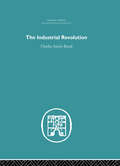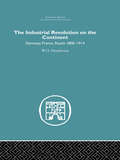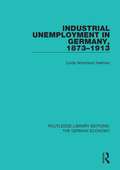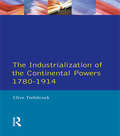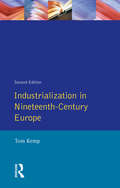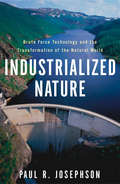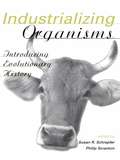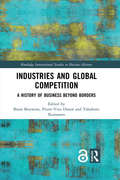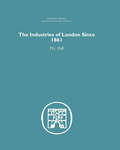- Table View
- List View
Industrial Revolution
by Charles Austin BeardFirst published in 2005. Routledge is an imprint of Taylor & Francis, an informa company.
Industrial Revolution on the Continent: Germany, France, Russia 1800-1914
by W.O. HendersonThis book was first published in 1961.
Industrial South Wales 1750-1914: Essays in Welsh Economic History
by W. E. MinchintonSouth Wales was one of the main centres of the Industrial Revolution in Britain but the story of the rapid growth of an industrial society there has not yet been fully told, since much of the work done has consisted of articles rather than books. This volume brings together a selection of important contributions hitherto only accessible in a large number of scattered periodicals. These articles have been selected to present a considered sequence and are preceded by an introduction which puts the story of the industrialization of Wales into perspective. They deal firstly with the problems of population and migration then with the basic industries of iron, coal, tinplate and copper. These are followed by essays on banking, and the volume concludes with contributions on trade unionism and building. This is by no means merely the story of regional development since the book has a wider appeal; a number of the articles are concerned with the links with America and with the place of Wales in the Atlantic economy. Amongst the authors are the late Sir Lewis Namier and some of the leading writers on the history of modern Wales including Brinley Thomas and A. H. Dodd.
Industrial Strength Bluegrass: Southwestern Ohio's Musical Legacy (Music in American Life)
by Fred Bartenstein Curtis W. Ell isonIn the twentieth century, Appalachian migrants seeking economic opportunities relocated to southwestern Ohio, bringing their music with them. Between 1947 and 1989, they created an internationally renowned capital for the thriving bluegrass music genre, centered on the industrial region of Cincinnati, Dayton, Hamilton, Middletown, and Springfield. Fred Bartenstein and Curtis W. Ellison edit a collection of eyewitness narratives and in-depth analyses that explore southwestern Ohio’s bluegrass musicians, radio broadcasters, recording studios, record labels, and performance venues, along with the music’s contributions to religious activities, community development, and public education. As the bluegrass scene grew, southwestern Ohio's distinctive sounds reached new fans and influenced those everywhere who continue to play, produce, and love roots music. Revelatory and multifaceted, Industrial Strength Bluegrass shares the inspiring story of a bluegrass hotbed and the people who created it. Contributors: Fred Bartenstein, Curtis W. Ellison, Jon Hartley Fox, Rick Good, Lily Isaacs, Ben Krakauer, Mac McDivitt, Nathan McGee, Daniel Mullins, Joe Mullins, Larry Nager, Phillip J. Obermiller, Bobby Osborne, and Neil V. Rosenberg.
Industrial Sunset
by Steven HighPlant shutdowns in Canada and the United States from 1969 to 1984 led to an ongoing and ravaging industrial decline of the Great Lakes Region. Industrial Sunset offers a comparative regional analysis of the economic and cultural devastation caused by the shutdowns, and provides an insightful examination of how mill and factory workers on both sides of the border made sense of their own displacement. The history of deindustrialization rendered in cultural terms reveals the importance of community and national identifications in how North Americans responded to the problem.Based on the plant shutdown stories told by over 130 industrial workers, and drawing on extensive archival and published sources, and songs and poetry from the time period covered, Steve High explores the central issues in the history and contemporary politics of plant closings. In so doing, this study poses new questions about group identification and solidarity in the face of often dramatic industrial transformation.
Industrial Unemployment in Germany 1873-1913 (Routledge Library Editions: The German Economy #5)
by Linda A. HeilmanOriginally published in 1991 this book provides a multi-faceted analysis of German unemployment between 1873 and 1913. It can also be read as an example of social scientific historiography during the fourth quarter of the twentieth century. Finally, the study has value for the comparative perspective it lends to current economic, social, and political turmoil in Germany, Europe, and the United States. While the precise conditions in the USA differ today, there are clearly still lessons to be learned on both sides of the Atlantic from the economic, social, and political dislocation, which accompanied industrial unemployment in Germany between 1873 and 1913. .
Industrialisation and Society: A Social History, 1830-1951
by Eric HopkinsIndusrialisation and Society provides an essential introduction to the effects of industrialisation on British society, from Queen Victoria's reign to the birth of the welfare state in the 1940s.This book deals with the remarkable social consequences of the industrial revolution, as Britain changed into an urban society based on industry. As the first nation to undergo an industrial revolution, Britain was also the first to deal with the unprecedented social problems of rapid urbanisation combined with an unparalleled growth in population.Industrialisation and Society looks at contemporary ways in which the government and ordinary people tried to cope with these new pressures, and studies their reactions to the unforseen consequences of the steam revolution. In particular, this indispensable book considers:* the Victorian inheritance* Edwardian England and the Liberal reforms* the two world wars* the Welfare State.
Industrialisation in the Non-Western World
by Tom KempThis new edition is fully updated and revised, incorporating the massive changes in the USSR and China in the 1980's. It offers a series of case-studies charting the progress and assessing the achievement of six industrializing countries outside the Western World. It covers the whole range of economic approaches, from those depending wholly on market forces to those that are completely planned.
Industrialisation of the Continental Powers 1780-1914, The
by Clive TrebilcockThe Industrialisation of the Continental Powers is both a broad survey of the process of European industrialisation from the late eighteenth century to the First World War, and also a closely argued comparative economic study of how this process was experienced by different great powers.
Industrialization in Nineteenth Century Europe
by Tom KempWritten for the layman as well as the economic historian this famous and much-used book not only presents a general synthesis of the pattern of European industrialisation; it also provides material for a comparative study by illustrating, in separate case studies, the specific characteristics of development in Britain, France, Germany, Russia and Italy.
Industrialized Nature: Brute Force Technology and the Transformation of the Natural World
by Paul JosephsonThe construction of the Three Gorges Dam on China's Yangtze River. The transformation of the Amazon into a site for huge cattle ranches and aluminum smelters. The development of Nevada's Yucca Mountain into a repository for nuclear waste. The extensive irrigation networks of the Grand Coulee and Kuibyshev Dams. On the face of it, these massive projects are wonders of engineering, financial prowess, and our seldom-questioned ability to modify nature to suit our immediate needs. For nearly a century we have relied increasingly on science and technology to harness natural forces, but at what environmental and social cost?In Industrialized Nature, historian Paul R. Josephson provides an original examination of the ways in which science, engineering, policy, finance, and hubris have come together, often with unforeseen consequences, to perpetuate what he calls "brute-force technologies"--the large-scale systems created to manage water, forest, and fish resources. Throughout the twentieth century, nations with quite different political systems and economic orientations all pursued this same technological subjugation of nature. Josephson compares the Soviet Union's heavy-handed efforts at resource management to similar projects undertaken in the United States, Norway, Brazil, and China. He argues that brute-force technologies require brute-force politics to operate. He shows how irresponsible--or well-intentioned but misguided--large-scale manipulation of nature has resulted in resource loss and severe environmental degradation.Josephson explores the ongoing industrialization of nature that is happening in our own backyards and around the world. Both a cautionary tale and a call to action, Industrialized Nature urges us to consider how to develop a future for succeeding generations that avoids the pitfalls of brute-force technologies.
Industrializing Organisms: Introducing Evolutionary History (Hagley Perspectives on Business and Culture #Vol. 5)
by Philip Scranton Susan R. SchrepferFirst Published in 2004. Routledge is an imprint of Taylor & Francis, an informa company.
Industries and Global Competition: A History of Business Beyond Borders (Routledge International Studies in Business History)
by Pierre-Yves Donzé Bram Bouwens Takafumi KurosawaChanges in the dynamics of economic activities since the last decades of the 20th century have yielded major changes in the composition of industries and the division of labor and production across different regions of the world. Despite these shifts in the global economy, some industries have remained competitive even without relocating their operations overseas. Industries and Global Competition examines how and why the specificities of certain industries and firms determined their choice of location and competitiveness. This volume identifies the major drivers of this process and explains why some firms and industries moved to other parts of world while others did not. Relocation was not the sole determinant of the success or failure of firms and industries. Indeed some were able to reinvent themselves at their original location and build new competitive advantages. The path that each industry or firm took varied. This book argues that the specific characteristics of each industry defined the conditions of competitiveness and provide a wide range of cases as illustrations. Aimed at scholars, researchers and acadmeics in the fields of business history, international business and related disciplines Industries and Global Competition exmaines the unique questions; How and why did the specificities of certain industries and firms determine their choice of location and competitiveness?
Industries of London Since 1861
by P.G. HallFirst Published in 2005. Routledge is an imprint of Taylor & Francis, an informa company.
Industry Integrated Engineering and Computing Education: Advances, Cases, Frameworks, and Toolkits for Implementation
by Mahmoud Abdulwahed Abdelaziz Bouras Laurent VeillardThis book introduces recent global advances and innovations in industry integrated engineering and computing education to academics, program managers, department heads, and deans, and shares with readers a critical perspective on future potentials in industry integrated engineering education. It covers topics and issues such as integrated engineering and computing education, part-time engineering masters programs, secure BIM learning, ethics, and IT workforce development. The book concludes with detail information on summarizing and extracting different frameworks, cases, and models into a practitioner toolkit, along with pragmatic recommendations for engineering education academics to quickly utilize, adopt, and adapt the toolkits for their own curricular development activities.
Industry Studies
by Larry L. DuetschFeaturing new chapters on casino gambling and the nursing home industry, and updated throughout, the new edition of this highly readable text analyzes well-defined industries from commodities and manufacturing to distribution and services, showing how firms compete with one another. Each study gives appropriate attention to government policies that have influenced competitive conditions in the industry, and the material is presented without the use of calculus so that anyone with some background in economic principles can benefit from it. The book provides balance in regard to the mix of industries dealt with, and also in the varying perspectives of the contributors.
Industry and Air Power: The Expansion of British Aircraft Production, 1935-1941 (Studies in Air Power #Vol. 5)
by Sebastian Ritchie Noel Sebastian RitchieThe author begins with a general survey of British aircraft manufacturing in the inter-war period. Policy, production, finance and contracts are examined, and the final chapter is concerned with the mobilization of the aircraft industry in 1939, and the emergency measures of 1940.
Industry and Civilisation (Routledge Revivals)
by C. Delisle BurnsOriginally published in 1925, Industry and Civilisation explores moral standards and ethics related to economic activities by providing a comprehensive view of psychological data obtained from the business world. As well as exploring general ethics and psychology, this work also focusses on the principles underlying economic legislation and how this impacted on moral standards of the time. This title will be of interest to students of Business and Economics.
Industry and Development in Argentina: An Intellectual History, 1914–1980 (Routledge Explorations in Economic History)
by Marcelo Rougier Juan OdisioThis book explores the twists and turns in Argentina’s modern economic history and the debates that raged there around a problem common to all former colonies: how to achieve a level of economic growth for its population in a world characterized by unequal economic relations between the industrialized nations of the north and the commodity producers of the south. This new perspective examines the history of ideas surrounding industrialization and economic development in Argentina, drawing on a rigorous investigation of multiple sources. It demonstrates Argentina’s role as a laboratory for and disseminator of ideas that would eventually become the common property of all the developing world. Influential thinkers such as Raúl Prebisch and Aldo Ferrer, leading figures in twentieth century Latin American economic thought, developed important ideas such as unequal international trade relations, the promise and limits of Import Substitution Industrialization, the role of the state in the development of a national capitalism. These were the forerunners of similar concerns in other countries in Latin America and elsewhere in the world. The book will be of interest to historians, economists, sociologists of economic development, and related disciplines concerned with questions of global economic inequality.
Industry and Intelligence: Contemporary Art Since 1820 (Bampton Lectures in America)
by Liam GillickThe history of modern art is often told through aesthetic breakthroughs that sync well with cultural and political change. From Courbet to Picasso, from Malevich to Warhol, it is accepted that art tracks the disruptions of industrialization, fascism, revolution, and war. Yet filtering the history of modern art only through catastrophic events cannot account for the subtle developments that lead to the profound confusion at the heart of contemporary art.In Industry and Intelligence, the artist Liam Gillick writes a nuanced genealogy to help us appreciate contemporary art's engagement with history even when it seems apathetic or blind to current events. Taking a broad view of artistic creation from 1820 to today, Gillick follows the response of artists to incremental developments in science, politics, and technology. The great innovations and dislocations of the nineteenth and twentieth centuries have their place in this timeline, but their traces are alternately amplified and diminished as Gillick moves through artistic reactions to liberalism, mass manufacturing, psychology, nuclear physics, automobiles, and a host of other advances. He intimately ties the origins of contemporary art to the social and technological adjustments of modern life, which artists struggled to incorporate truthfully into their works.
Industry and Politics in the Third Reich: Ruhr Coal, Hitler and Europe (Routledge Library Editions: Nazi Germany and the Holocaust)
by John GillinghamWhen originally published in 1985 this was the first detailed study of business in Nazi Germany. Drawing on a wealth of new evidence from government and private archives, the book throws light on the important role played by Germany heavy industry in preserving traditions valuable for the post-Nazi future. Contrary to widely held beliefs, the industrialists of the Ruhr did not master-mind the economic strategy of the third Reich, nor were they the helpless victims of Hitler’s tyranny. In this penetrating study, the author reveals that while the management of the coal industry in the Ruhr certainly cooperated with Hitler, they did so only to the extent that it served their own purposes, which were far less destructive than those of the regime.
Industry in England: Historical Outlines (Routledge Revivals)
by Henry De GibbinsOriginally published in 1912, Industry in England provides a complete history of industry and industrial changes in England from pre-roman times to modern England as it stood in the early twentieth century. Using Gibbons’ previous text The Industrial History of England as a base, this work aims to tackle economic and industrial questions in relation to social, political and military contexts in further detail to present a full picture of what life in England was like at the time these industrial changes took place and how this influenced industry. This title will be of interest to students of History.
Industry in the Wilderness: The People, the Buildings, the Machines — Heritage in Northwestern Ontario
by Joan MageeFilled with photographs, both historic and contemporary, this engaging book looks at the industrial pioneers of northwestern Ontario, and the activities which brought them to the wilderness: surveying, railroading, lumber, gold, bush piloting, transportation, and hydro power. Rasky lets the pioneers tell their own story, through their own reminiscences, and by the monuments they have left behind. Published with the assistance of the Ontario Ministry of Citizenship and Culture, and the Ontario Ministry of Northern Affairs.
Indy 500, The: 1956-1965 (Images of Sports)
by W. C. Madden Ben Lawrence Christopher BaasThe 1950s and early 1960s are considered by many to be the Golden Era of Racing at the Indianapolis 500, and photographer Ben Lawrence was on hand taking photos of the Greatest Spectacle for the Indianapolis Times. During that era, Ben captured many images of the race and race events that surrounded the Indy 500. He was there when Bill Vukovich met his fate in 1955. He photographed the first Indianapolis 500 Parade, which has become an annual event. He captured A.J. Foyt winning his first race at the Brickyard. He was on hand to photograph the breaking of the 150-mph barrier. Then he saw the transition from the front-engined Offenhauser to the rear-engined Lotus-Fords, which ended the Golden Era.
Inequality and Nutritional Transition in Economic History: Spain in the 19th-21st Centuries (Routledge Explorations in Economic History)
by Francisco J. Medina-AlbaladejoFood consumption and nutrition are historically among the most characteristic features of inequality in living standards driven by socioeconomic, gender, generational and geographical reasons. Nutrition directly impacts mortality, life expectancy, height and illness and thus becomes a good indicator of living standards and their evolution over time. However, one issue that remains unresolved is how to measure past diet inequalities with the available sources. This book evaluates nutritional inequalities in Spain from the nineteenth century to the present day. It explores the socioeconomic, gender, generational and geographical variations in food consumption and nutrition in Spain during this period. Deriving historical data on nutrition and diet has always been difficult due to issues with available sources. This book adopts a multi-dimensional approach and two complementary methodologies capable of presenting a more comprehensive picture: the first analyses diets based on primary sources, while the second examines the effect of nutritional inequalities on biological living standards, with special emphasis on average height. This combination allows for greater precision than previous studies on the impacts of food inequality. This book will be of significant interest to scholars from different academic branches, especially historians, economic historians and historians of science, economists, and also doctors, endocrinologists, paediatricians, anthropologists, nutritionists and expert in cooperation and development.
